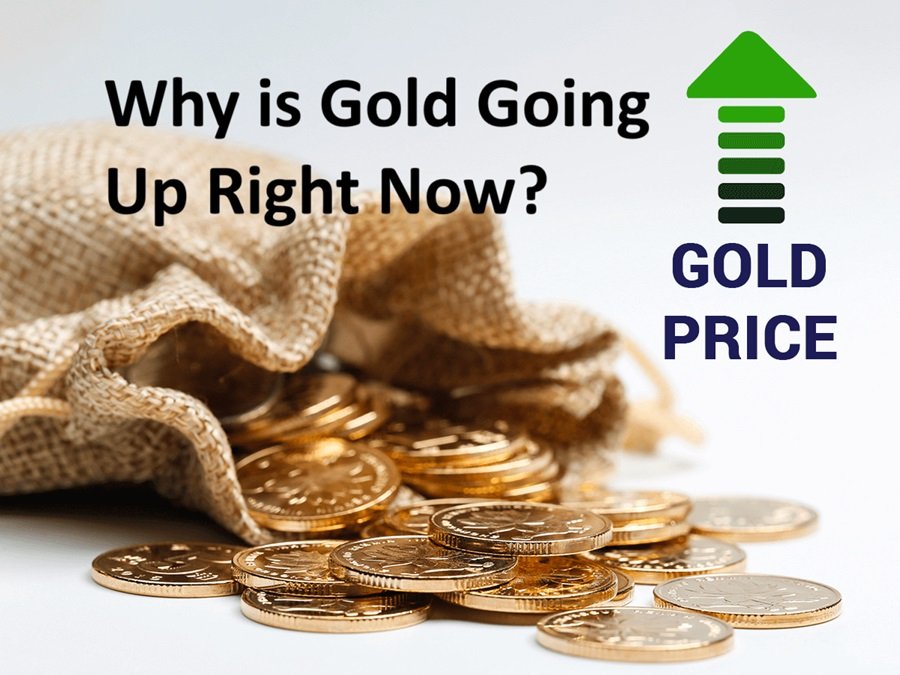Why is Gold Going Up Right Now?
Gold has long been seen as a store of value and a safe haven for investors during times of economic uncertainty. In 2024, the precious metal has once again become the focus of attention as its value has been steadily rising. This begs the question: why is gold going up right now? Several factors are driving the current increase in gold prices, including inflation, economic instability, and investor sentiment. In this article, we’ll dive deep into the reasons behind gold’s recent price surge and explore the historical context that makes gold such a valuable asset during volatile times.
Gold is hitting record highs. But this new rally is bucking long held trends for the commodity, and bringing in a new class of investors. Typically, gold prices peak in periods of economic weakness and recessions etc…
Open a FREE Bullion Vault account today with no obligation to trade! BONUS: Sign up now and receive a risk-free 1/8 oz (4g) of silver to kickstart your journey into precious metals investing

How Inflation Impacts Gold Prices
Inflation is one of the most significant factors influencing gold prices. When inflation rises, the purchasing power of currency declines, making it less valuable over time. This forces investors to seek alternatives that can preserve wealth. Historically, gold has proven to be a hedge against inflation because, unlike fiat currency, its supply is limited. As inflation erodes the value of paper money, investors turn to gold to protect their wealth.
Gold’s price increases as inflation rates go up, driven by the idea that gold retains its value when money loses its purchasing power. In recent years, the global economy has seen rising inflation due to factors like supply chain disruptions, increased government spending, and the lingering effects of the COVID-19 pandemic. These pressures have prompted investors to flock to gold, driving up its value.
Will Gold Prices Continue to Rise?
Predicting the future of gold prices is challenging, but many experts believe that gold’s upward trend will continue, particularly if inflation remains persistent. Central banks worldwide have adopted loose monetary policies in response to economic challenges, which has led to concerns over inflation becoming a long-term issue. In this environment, gold remains an attractive asset for investors looking to preserve value.
Moreover, rising geopolitical tensions and economic uncertainty often spur a “flight to safety,” where investors move their capital from riskier assets like stocks into stable assets like gold. As long as these conditions persist, the demand for gold is likely to stay strong, supporting continued price increases. However, factors such as changes in interest rates, a strong recovery in the stock market, or reduced inflationary pressures could temper this growth.
What Causes Gold Prices to Increase?
There are several factors behind the rise in gold prices, but three key drivers stand out: inflation, currency devaluation, and economic instability. As we’ve already discussed, inflation is a primary cause. Currency devaluation, especially the weakening of the U.S. dollar, also plays a significant role. Since gold is priced in U.S. dollars, when the dollar weakens, gold becomes cheaper for foreign buyers, increasing demand and pushing up the price.
Economic instability is another critical factor. When economies face uncertainties, be it due to recession fears, rising debt levels, or geopolitical conflicts, investors tend to shift toward gold as a safe investment. Historically, gold has been a reliable store of value, which makes it particularly attractive during periods of uncertainty.
Historical Reasons for Gold Price Increases
Historically, gold prices tend to rise during times of economic instability and inflation. One of the most notable examples of this occurred during the 1970s when the U.S. experienced double-digit inflation. During this period, gold prices surged as investors sought to protect their wealth against the rapidly depreciating dollar. By 1980, gold had reached a then-record high of $850 per ounce.
Another example is the 2008 global financial crisis, which saw gold prices skyrocket as investors sought refuge from collapsing stock markets and failing financial institutions. In the aftermath of the crisis, gold reached an all-time high of $1,920 per ounce in 2011.
These historical instances underscore gold’s role as a hedge during uncertain times. The current rise in gold prices follows a similar pattern, driven by inflation concerns, geopolitical tensions, and economic volatility.
How Economic Instability Drives Gold Prices
Economic instability is one of the most potent drivers of gold prices. When markets are unstable, investors look for assets that are likely to retain their value, and gold is usually at the top of the list. This flight to safety can be triggered by several factors, such as political unrest, recession fears, or natural disasters. The uncertainty created by these events often results in increased demand for gold.
In recent years, factors like the war in Ukraine, global supply chain disruptions, and lingering fears of a potential recession have contributed to an environment of instability. Investors are increasingly worried about the health of the global economy, leading many to invest in gold as a safeguard.
Is Gold a Good Investment During Inflation?
Yes, gold is generally considered a good investment during periods of inflation. As inflation increases, the value of traditional assets like stocks and bonds can decline, while the purchasing power of cash diminishes. Gold, however, often retains its value or even increases in price during these times, making it a solid option for preserving wealth.
Unlike fiat currency, gold is a finite resource that cannot be printed or artificially created. Its value is intrinsic, which makes it a reliable store of value when inflation eats away at the value of paper currency. This makes gold particularly attractive to investors looking to protect their wealth from the corrosive effects of inflation.
Correlation Between Gold and Inflation
There is a strong correlation between gold and inflation. Historically, as inflation rises, so does the price of gold. The reason for this is that inflation reduces the purchasing power of currencies, making them less attractive to hold. Gold, on the other hand, is viewed as a stable store of value, and its price tends to increase when inflationary pressures are high.
In times of high inflation, gold’s price typically rises as investors seek to hedge against the diminishing value of currency. This correlation is one of the reasons why gold remains a popular investment during times of economic uncertainty and inflation.
Why Do Investors Buy Gold During Economic Crises?
Investors flock to gold during economic crises because it is seen as a safe haven asset. Gold’s value has historically remained stable or even increased during periods of economic turmoil, making it an attractive option for those looking to preserve their wealth.
During crises, other investments, like stocks or real estate, can become highly volatile, and the risk of loss increases. In contrast, gold’s long-standing reputation as a reliable store of value makes it a go-to option for investors looking to mitigate risk. Additionally, gold is not tied to any government or financial institution, which gives it a unique level of independence from the financial systems that might be in jeopardy during a crisis.
Future Predictions for Gold Value
The future of gold prices largely depends on the trajectory of global economic conditions. If inflation continues to rise and economic instability persists, we can expect gold prices to maintain or even increase their upward trend. However, if central banks successfully control inflation and stabilize economies, we could see a cooling of gold prices.
Nevertheless, gold will likely remain a crucial component of any diversified investment portfolio. Its historical role as a hedge against inflation and economic instability means it will continue to be a valuable asset for investors in the foreseeable future.
Conclusion
Gold’s current price increase is driven by a combination of inflation, economic instability, and investor behavior. As inflation erodes the value of paper currency, and economic uncertainties loom, gold continues to serve as a safe haven for preserving wealth. Whether gold prices will continue to rise depends on several factors, including inflation trends and global economic conditions. However, based on historical patterns, it’s clear that gold will remain a sought-after investment during times of financial uncertainty.
Open a FREE Bullion Vault account today with no obligation to trade! BONUS: Sign up now and receive a risk-free 1/8 oz (4g) of silver to kickstart your journey into precious metals investing





